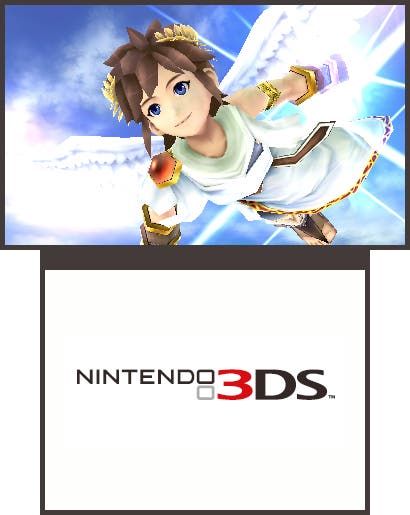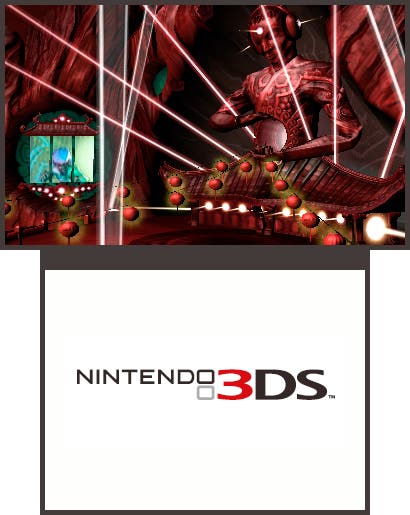Digital Foundry vs. 3DS
Tech talk and brand new demo analysis.
So, with the demos out of the way, it's time to get a closer look at the Nintendo 3DS' rather nifty party trick. The hardware features a total of three cameras, one stationed directly above the 3D screen, and another two on the lid. Why two cameras on the lid then? Welcome to the world of stereo 3D photography.
We never anticipated Nintendo incorporating this, and it really is cool. A simply capture tool allows you to line up and snap your chosen subject (with a stereo 3D viewfinder of course), and then you can view the images you've taken any time you want on the 3D screen, using the d-pad to adjust the parallax. It works, it's uncanny, and it's a great talking point.
What you can actually do with these images beyond looking at them on the 3DS screen remains to be seen, and you can't help but wonder what plans Nintendo has for this. In the other demos and games there was no need for this at all, and Nintendo builds its machines to a cost: there's no scope in this company's masterplan for any superfluous tech.
One can only imagine that there are plans in place for getting the most out of this addition, but in the here and now I can say with confidence that it is just very cool and I'm glad that Nintendo went for it.
Other elements of the 3DS remain something of a puzzle. At the conference Nintendo confirmed that the 3DS features a motion sensor and gyroscope. This is curious as there is a limited viewing angle with the stereoscopic screen, and extreme wobbling of the unit kills the 3D effect, as you would expect from a game supporting actual motion of the console.
One thing to be clear of here though is that, generally speaking, the sweet spot for the 3D effect is much larger than you would think. There is some occasional cross-talk (i.e. image data for one eye encroaching onto the other eye) but for the most part the effect is crystal clear and you won't have any problem enjoying the full effect.
Any kind of fast motion game using the sensors and gyroscope must surely be incompatible with the 3D screen, though, so the question is, why is the kit in there, and can it really be the case that Nintendo would allow non-3D titles to be released for the 3DS in order to best use the new sensors? Wouldn't this introduce a huge level of potential confusion for game buyers?


Another massive surprise in the 3DS package is the support for 3D movie playback. I had the chance to view two 3D trailers: Disney's Tangle and Dreamworks' How to Train Your Dragon. Oli pointed out that the 3D effect here is rather subtle, and so it is. There are two likely reasons for this. First of all, you're viewing the content off the back of playing video games which really exercise the full depth available. Secondly, these trailers were designed to be viewed on a honking great cinema screen, not a relatively tiny 3.5" screen!
After my first taste of 3DS, I was somewhat sceptical about how these movies would work on the screen. The game content has a lenticular look about it, with pixel edges fairly evident despite the seemingly high DPI of the screen. My fear was that you'd see the same edges on the movie content.
Thankfully I was proved completely wrong. Movies playback beautifully on the 3DS screen, and while the 3D effect is subtle, it only takes a short while to grow accustomed to it, and turning off the 3D functionality clearly impacts the image in a negative way. Just about the only criticism you can have is that the screen itself is very small at 3.5", so not exactly immersive for movie viewing.
Speaking of which, it is interesting to point out that the 3D depth slider doesn't work for movie playback, where you effectively get a choice of watching in either two or three dimensions with no tweaking of the latter. This effectively confirms that the 3D slider is computationally altering the twin in-game 3D cameras on the fly in actual 3DS software, and that the 2D mode most likely works simply by turning off the output to one eye and adjusting the cameras accordingly.
So, bearing in mind the relatively unfettered access we had to the kit for an extended period of time, were there any other points of interest we've not yet brought to the table? Not really, except for final confirmation that within the development community, the 3DS is indeed codenamed Nintendo CTR. That's what the debug game launcher code we spied on the development units said anyway.
In closing, it's fair to say that Nintendo rarely gets any love from Digital Foundry, and arguably that's something we need to look at (what other platform holder is so committed to 60FPS gameplay, for example?). With Nintendo 3DS, that is set to change, because the arrival of the new handheld is clearly a major event.
In many ways, this new device is classic Nintendo. It's clearly built to a cost and the chances are that the platform holder will be in profit on this unit from day one. Just like Nintendo DS in its day, the GPU is under-powered, but on the flipside this should help immeasurably in maintaining battery life. And again, just like classic Nintendo hardware, it has a concept that is way ahead of the competition. The 3D screen propels the visuals into a different league, it's that good.
The inclusion of stereo 3D is also a masterstroke from Nintendo because it differentiates the handheld in a savagely competitive environment. While iPhone may be hoovering up more market share in the mobile arena, constantly re-inventing itself year after year with new hardware and features, it doesn't do 3D and likely won't for years to come, if ever. Nintendo has a unique selling point and it's certain to be another monster hit.
